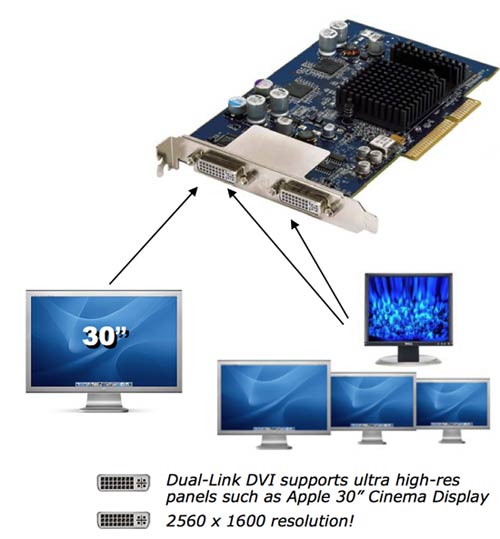ATI Radeon 9600 Pro Mac & PC Edition: One Card for All
by Anand Lal Shimpi on August 19, 2005 12:54 PM EST- Posted in
- Mac
The Card
As its name implies, the Radeon 9600 Pro Mac & PC Edition is a single card that will work in both Macs and PCs. The dual compatibility is made possible with only a single ROM chip loaded with both sets of firmware. The card actually boots as a PC card, but if installed in a Mac, the OS will override the PC firmware and start it up as a Mac card. On a PC, the system isn't at all aware of the Mac firmware present.

With the RV350 GPU at its heart, the Radeon 9600 Pro Mac & PC Edition isn't a card for those looking for ridiculously high frame rates in games. Instead, it is for those users who want a video card for everything but games. In particular, the 256MB frame buffer of this card is one of its biggest selling features. At the 2560 x 1600 native resolution of the 30" Cinema Display, 256MB of local frame buffer is necessary to avoid swapping to system memory when you have a lot going on in OS X. In fact, the general UI performance of the 256MB Radeon 9600 Pro Mac & PC Edition is identical to that of a Radeon X800 XT Mac Edition, even when running on a 30" Cinema Display at native resolution. So, for those who don't need the gaming performance of a X800 XT, the new 9600 Pro gives you the same 256MB of memory, but at a lower price point.
Like ATI's other 96xx Mac offerings, the 9600 Pro Mac & PC Edition is entirely passively cooled, and thus, is silent. It is quite surprising how much of a difference a GPU fan can make to the overall noise output of a stock G5 system, but it does make a major difference.
ATI is pricing the 9600 Pro Mac & PC Edition at $199, which is rather expensive for a 9600 Pro; the primary reason for the premium is due to the 256MB of memory. ATI is hoping that retailers will stock this new dual function card much like the rest of their cards; thus, giving everyone easy access to it. Given ATI's prevalence in retail stores like Frys, Best Buy, Future Shop and CompUSA, we wouldn't be too surprised to find the Radeon 9600 Pro Mac & PC Edition on those stores' shelves in the near future.










34 Comments
View All Comments
Fulie - Saturday, December 10, 2005 - link
I just stumbled on to this write up and trying to get information on blending systems has been a major pain. I have a pc that is used for viewing images at high res. and an unused 23" older mac lcd (clear surround with a seperate power source and ADC TO DVI connector) display that I would like to use with this pc. I don't need game speeds but use dvd video on occasion. From the specs. It sounds like it will work, any ideas?sprockkets - Saturday, August 20, 2005 - link
the pinout of the card looks agp 2x and not 4x/8xPrinceGaz - Friday, August 19, 2005 - link
Just a minor amendment. On page 2 you mention that "The actual GPU isn't any different than what we've had on the Mac and PC side for a while; it still runs at 400MHz like the OEM Radeon 9600XT and 9650".The GPU of a 9600XT is clocked at 500MHz, not 400MHz. It is the 9600Pro which has a GPU clocked at 400MHz. Which is what you would expect as the card you reviewed is a 9600Pro.
a2daj - Tuesday, August 23, 2005 - link
The Apple OEM Radeon 9600 XTs were clocked at the same speed most PC manufacturers clocked their retail Radeon 9600 Pros. The OEM 9600 Pros were clocked even slower when they were first introduced.tooki - Friday, August 19, 2005 - link
1. This is not the first cross-platform card. Most 3Dfx cards were cross-platform.2. The Power Mac G5 does not use a SATA optical drive, it's standard parallel ATA.
3. ADC's high power requirements are because of ADC's ability to drive a 17" CRT display, not because of large LCDs.
stratusgd - Saturday, August 20, 2005 - link
Actually, all G5 systems that Apple sells come with SATA drives, not PATA. Go look at Apple's website.SDA - Saturday, August 20, 2005 - link
The poster you are replying to is referring to optical drives, not hard drives. Optical drives are drives that read or write optical media such as CDs and DVDs.a2daj - Friday, August 19, 2005 - link
"1. This is not the first cross-platform card. Most 3Dfx cards were cross-platform."A Mac specific firmware had to be on the 3dfx cards starting with the Voodoo3s. The Voodoo3s were unsupported but you can flash them to run in a Mac. You had to reflash them to run in a PC. The Voodoo 4s and 5s had Mac specific firmware. They had to be flashed to run in PCs. You couldn't take a PC version and put it in a Mac and get it to run without flashing it.
The Voodoo1s and 2s were just pass through cards which only did 3D so they didn't need Mac firmware to handle the 2D 16 bit Mac OS issues (5551 (Mac) vs 565 (PC))
lancediamond - Friday, August 19, 2005 - link
Not entirely clear if you could do that unless I missed it - if so, that'd be sort of cool maybe?a2daj - Friday, August 19, 2005 - link
Yes. That's the target PC audience.